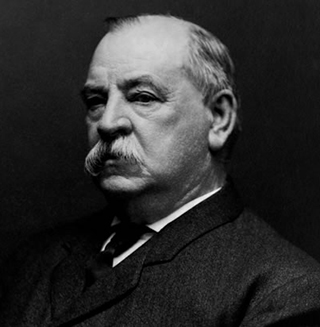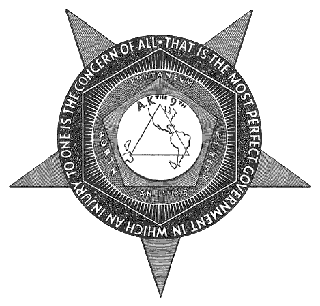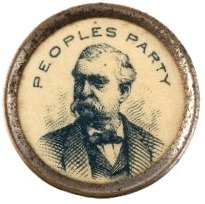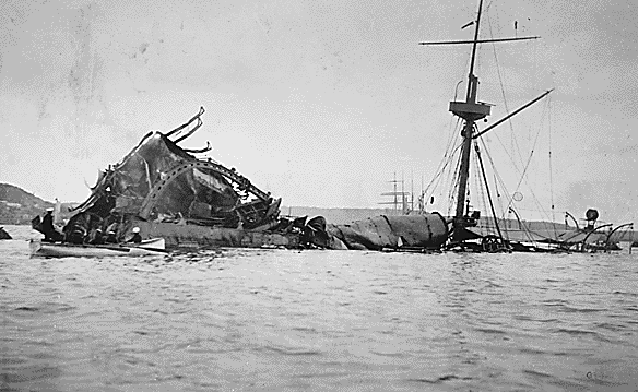by Mark Lause
January 12, 2015
Reconstruction of the two-party system became essential to the general Reconstruction after the Civil War, establishing some features that remain clear today. As such, the arrangement of the parties became an essential aspect of the betrayals associated with the Reconstruction of the post-war South.

Grover Cleveland.
Over the 67 years from the murder of Abraham Lincoln to the election of Franklin D. Roosevelt, most participating voters cast Republican ballots. In fact, over this long expanse, only two Democrats won the presidency, Grover Cleveland and Woodrow Wilson, both victories the result of splits among the Republicans. Despite the dominance of a Republican Party, very little happened over these years to extend the idea of representative government beyond the limitations it had for generations.
While the Republicans prevailed throughout, Americans experienced two distinct phases in the evolution of the party system. Prior to the turn of the 20th century, the reunited national government established a great deal more power over almost everything, and used it to foster industry and business almost relentlessly. Later, the resulting social turmoil—crime and disease as well as popular discontent—required a different, more intense government regulation to keep capitalism sustainable. This regulatory authority gave the two-party system an opportunity to expand popular participation in electoral politics, while slowly making the Democrats the only respectable alternative to the dominant Republicans.
Reconstructing the Two-Party System
The fate of post-Civil War Reconstruction dashed hopes that a federal union might emerge from the war grounded in freedom and equality. This did not simply betray the promise of freedom and equality to the freed people coming out of slavery, whose constitutionally guaranteed rights were never secured. The process began with the Native peoples, who faced the application of the Anglo-Canadian reservation policy. And it ended with turning over the poor whites to the leadership of the old secessionists. More accurately, denial of citizenship to any part of the population fundamentally denies the entire people a representative government. The outcome severely constrained the extent to which the government would take on a general reconstruction of how it did things in the past.
An essential if often neglected feature of this would be another Reconstruction—of the two-party system. After an all-too-brief clash with the party’s Radical caucus, the Republicans quickly took the course not just of reconciliation with the old Confederacy, but of emulating it. As the antebellum cotton factors had used all sorts of rhetoric and rationalizations to justify the use of government to promote their own interests, the postwar “Robber Barons” did the same on behalf of their own railroad and industrial concerns.
The bipartisan abandonment of Reconstruction reflected the assumption that what was good for privately owned industry was good for the nation. In the aftermath of the Civil War, government concerns focused on the development of industry, particularly the railroads. By 1883, the national and state governments gave land equivalent to the size of Texas to the railroads. The dominant ideology became the savagery that has been called “Social Darwinism.” Both parties used the army to crush rebelliousness among native peoples and against strikes. The emergence of news syndicates and services along with rising costs were beginning to restrict diversity of perspective.
Through the first decades of this period, the machine leadership of Marcus Hanna in Ohio dominated the Midwestern and national Republican Party. After Lincoln’s vice president Andrew Johnson faded from the scene, the Grand Old Party elected Ulysses S. Grant, Hayes, James Garfield and William McKinley—all Midwestern Civil War heroes. Chester A. Arthur, who became president after Garfield’s assassination, came from New York.
Democratic leaders appealed to the tried and true agrarian values, coupled to the concerns of small scale industry and those larger economic enterprises disadvantaged by government policy. Insofar as this base impelled the Democrats to formulate some alternative ideology, it centered on an old-fashioned agrarianism, tinged at times with some pro-regulatory reformism. Interestingly, though, the only Democrat elected president in this period, Grover Cleveland, had been a “gold bug” Democrat from western New York capable of appealing to the same constituencies as the Republicans.
Major party identification had far less to do with platforms or ideas than demographics. Rural and small-town white Protestants supported the Republicans in the North and the Democrats in the South. While African Americans overwhelmingly voted Republican where they could, immigrant and Catholic voters cast Democratic ballots, as did many under the influence of big city political machines. In short, each of the parties won elections not based on what they had delivered or promised to voters but out of fear of the alternative. Democrats continued to use explicit appeals to white supremacy. Republicans “waved the bloody shirt,” reminding voters of the legacy of the war, and denounced Democrats as the party of “Rum, Romanism, and Rebellion.”
Candidates themselves formulated the differences in often arcane rhetoric. The Republicans promised high protective tariffs that would encourage national industry, ensuring business prosperity that would trickle down to the workers as higher wages. The Democrats insisted that they, too, favored tariffs, though only to bring more revenue into the treasury. Either way you were going to have a tariff. What the parties did offer voters were their claims to favor honest, clean government. In the critical election of 1876, both parties essentially ignored the issues of Reconstruction to campaign as reformers—Rutherford B. Hayes running as an advocate of civil service reform, against a Democratic opponent who had gained national prominence taking on the notorious Tweed Ring in New York City.
The attempt of each party to charge the other with corruption and fraud had merit on both sides. As the many critics of the political system of the day pointed out, it suited Republicans to permit a grotesque level of Democratic vote fraud in the South because they had abandoned any hope of carrying those states, and the fraud—along with its largely racial character—gave Republican orators something to discuss in the North. At the same time, Democrats complained of the overt Republican vote fraud in Northern factory towns where the bosses gave their workers part of the day away from the machines to ferry them in wagons to the polls for a supervised vote. This practice, too, did the Democrats no damage and gave them a counterargument to the fraud in the South.
Pressures for Change

The seal of the Knights of Labor.
This striving for stability by the elite inspired insurgent concerns, rooted in an abiding popular fear of unaccountable authority exercised in support of wealth and power. Massive numbers joined the local granges of the Patrons of Husbandry, which admitted women and had female officers. While this organization deferred to white Southerners by excluding African Americans, some local groups simply admitted them anyway and a number launched their own Industrial Brotherhood. The latter merged into the regionally important Sovereigns of Industry and the Knights of Labor. More radical organizations such as the International Workingmen’s Association and kindred associations also became prominent, if remaining quite small by comparison. Organizations of African-Americans and women also appeared, their concerns focused increasingly on their civic exclusion.
These efforts engaged hundreds of thousands of Americans who learned how to organize meetings, make collective decisions, organize mass demonstrations, conduct strikes, and confront employers and the government with their demands. Their efforts to form cooperatives that would gradually displace capitalism, and the insistence of these workers on their rights to govern their own affairs in the workplace, caused no end of trouble. Mass strikes occurred regularly after the insurrectionary 1877 railroad walkout. Many of these active citizens repeatedly tried to follow the example of the Republican Party in constructing a new, responsive third party. This wave of independent parties initially converged in the National, Independent, or Greenback Party, alongside which a number of smaller, local labor parties, as well as a tiny new Social Democratic Workingmen’s Party regrouped as the Workingmen’s Party of the United States in 1876.
With the great national railroad strike of 1877, which became a general strikes in places, the Greenbackers took a more explicitly pro-labor stance and the WPUS entered local politics, all gaining some success. Early in 1878, the WPUS remained itself the Socialistic Labor Party and the Greenbackers, having assimilated a number of new local labor parties, renamed itself the Greenback-Labor Party. These converged in the 1880 presidential campaign, which raised not only the grievances of farmers and workers, but advocated woman suffrage and protested the increasing exclusion of African-Americans from civic life in the South. Afterwards, however, issues of race and sectionalism undercut the movement, though it persisted in the west. Membership in the socialists’ party went into free fall.
A resurgent labor movement offered other alternatives. Anarchists, with large followings in New York and Chicago, generally—though not always—avoided electoral politics. A new land reform campaign launched around Henry George’s book Progress and Poverty inspired massive new local labor party campaigns, notably his own mayoral race in New York City. Although the Democrats won that election—they counted the ballots—the United Labor candidate outpolled the Republican, a police commissioner named Theodore Roosevelt.
The persistent insurgency in those western centers of electoral independence—Texas and Kansas—pitted farmers against, respectively, Southern Democrats and Northern Republicans. Their organizations, together with the Knights of Labor and a range of other groups, combined to launch the People’s Party. The “Populists” were so-called because of their desire to place people above the imperatives of the profit system. Although derailed and crushed after 1894, parts of the movement contributed directly to the emergence of a new mass socialist party. Since the Henry George campaign of 1886, Daniel DeLeon had reorganized and revitalized socialist ideas with the Socialist Labor Party. By the late 1890s, as the Populists disintegrated, elements of the SLP joined other socialist currents to form the Social Democracy—what became the Socialist Party of Eugene V. Debs.
Why Third Parties Stumbled
All these movements remained weakened by the fact that Reconstruction had imploded, which excluded legions of working people and farmers from politics, but even more fundamental problems plagued them. All third-party efforts entered a game whose rules virtually assured their marginalization.
Part of nationalizing the two-party rivalry established the national faith that the system had evolved to represent the will of the voters. As we have seen, it never actually did so, but all politicians and virtually all pundits implicitly and explicitly turn every election into a well-practiced celebration of that faith. To this day, of course, the academic, educational and journalistic industries ritually convey the litanies of this faith as part of their daily functions. As with all faiths, those unwilling to step outside of it, even temporarily, will not be able to examine the mechanics of this process critically. However, those who do so risk finding themselves heretics excluded from the self-defined “serious mainstream.”

A Peoples Party button from the James B. Weaver campaign.
The “journalistic” component of Big Business provided an allegedly independent adjudicator for defining what would be acceptable in the aftermath of the Republican ascendancy. In his 1880 Greenback-Labor campaign, James B. Weaver got considerable coverage in the early weeks. However, when he tried to make an issue of the ballot and Black exclusion in the South, Democratic sources broke an entirely fictional story that he was in the pay of the Republicans. The Democratic press across the country replicated the story, announcing that there was no need to cover more than one Republican contender. And the Republican papers saw no further need to discuss the third party campaign if the Democrats were not doing so.
While all of this assured that third parties would find success elusive, it accorded them an important role in permitting the further stability of two-party rule. At the most basic level, either of the parties, under the right circumstances, could find partisan uses for an ostensibly independent bid for power.
After the implosion of Reconstruction, Republicans in the South found their condition hopeless, as did Democrats in New England. Factions of both episodically gave strong support to independent politics in hopes of breaking down the locally dominant parties, though the national leaderships remained ambivalent about such ventures. More fundamentally, though, third parties provided the dominant parties a clear measure of how and why public sentiment might be threatening to outgrow the juvenile distractions of tariffs and “identity politics” (in the original sense). Those extensive third party efforts in the Reconstruction and its aftermath redirected one or both of the major parties to issues and concerns that required attention.
Essential to this, the two-party system learned to translate insurgent concerns into a “public opinion” that could be safely addressed in the language of stability and order. Mere protest, then, permitted an ongoing renewal of the legitimacy of the existing power structure. Much of this turned on the success of the two parties in using the threat allegedly posed by “the Other.” Both parties agreed on the subjugation of the native peoples in the unsettled western territories internal to the United States. Beyond this, the more agrarian Democrats had some very traditional mild interest in Latin America, while the more commercially concerned Republicans tended to look towards Asia.
The Spanish-American War at the close of the century addressed these bipartisan ambitions, waging wars to finally secure U.S. dominion over Cuba but also over the Philippines. Rudyard Kipling, the great British poet of imperialism versified his salute to the American willingness to “take up the white man’s burden.”
What Theodore Roosevelt called a “splendid little war” established all the key features of later conflicts in which the United States would chose to engage. The American people had never gone to the polls and elected pro-war candidates to take power. Rather, the decisions to launch the conflict took place behind closed doors. Those who wanted war leaked disinformation (about the sinking of the USS Maine, in this case), shaping public perceptions in such a way as to where the people would permit waging the war, and then went to war claiming that public had insisted upon it.
 The wreckage of the U.S.S. Maine.
The wreckage of the U.S.S. Maine.
On the home front, the Panic of 1893 had plunged the country into a depression. The armed resistance of Native Americans came to an end and Frederick Jackson Turner, of the new historical profession, read his influential paper declaring an end to the frontier. The Midwest, which had supplied most of the presidents since the Lincoln, faded in importance before New York and the centers of financial capital in the northeast.
Progressive Reform: Moving Forward?
The Progressive reform movement that emerged around the turn of the century marked the greatest political shift since the Civil War, and represented the system’s response to citizen discontent and the threat of alternative parties. The 1912 presidential election illustrates how the politicians themselves acknowledged the deep desire of the American public: each and every candidate heading the parties ran as a “Progressive.”
Pro-gress–as the opposite of re-gress–meant moving forward rather than going backward, but moving forward all depends on which way you’re facing. So the Niagara movement—what became the National Association for the Advancement of Colored People—fell under the rubric of “Progressive,” as did the “New South” segregationists imposing Jim Crow. One kind of “progress” not only never predominated, but would be largely repressed in this period.
Voters’ choice between two parties had nothing to do with this great change. That is, no one party would take up the idea of greater government involvement in the economic and social life of the nation and triumph at the polls over a more conservative position taken by the other party. Rather, the “Progressive” idea gained currency in both parties, as reflected by the ascendancy of figures such as Teddy Roosevelt among the Republicans and William Jennings Bryan among the Democrats. TR’s entry into the White House—and that of his successors, William H. Taft and Woodrow Wilson—reshaped the role of government.
The older rules that informed how the economy and government functioned had permitted the chaotic phase of industrial expansion, but that process had run its course and became an obstacle to its future, fuller development. As business took up the idea of “scientific management,” politicians took up “Progressive” politics. Capitalist rule now required change. Unsanitary conditions in the cities not only affected the working poor but interfered with production. Once germinated, diseases growing from the slums did not stay there. Access to cheap child labor discouraged investment in new technologies requiring more skill, experience and strength—nor did it fuel the kind of mass public education then permitting Germany to leap forward industrially and scientifically. Simply put, the idea of a legislated minimum wage, unemployment insurance, workmen’s compensation and other reforms suited a restructuring of the American economy.
The War and the 1920s
In Germany, reforms sought to undercut the threat of a mass socialist party and to bring workers into a partnership around the impression of “social imperialism.” Although it faced a serious test in the crisis of 1914 with the outbreak of the world war, only years of hunger, disease and death brought loyalties to a breaking point. Wilson’s United States initially avoided being pulled into the industrial meat grinder, but encouraged investments in British victory, which meant that when the Russian Revolution of 1917 threatened Britain’s victory, America had to enter the war directly. This made Britain’s “war to end all wars” into the U.S. “war to make the world safe for democracy.”
As with the sinking of the Maine in 1898, these justifications proved less than honest. However, backed by a virtual monopoly over the media, they marked the extent to which this or any modern government could twist the truth to its own purposes and their people would accept it. Despite serious losses, the United States emerged from the war as the only industrial power essentially unscathed. Neither major party objected to the war, nor to the treatment that waging it imposed on the people.
So too, by the 1920s—under the Republican administrations of Warren G. Harding, Calvin Coolidge, and Herbert Hoover—American capitalism entered the age where fortunes could be made through a consumer economy. Yet the prosperity associated with the period always remained very restricted to certain sectors. The white middle class prospered and many skilled workers with them. Industrial workers and people of color did not fare so well. The difference turned largely on the question of creditworthiness, determining who could participate in a better life that had to be bought on an installment plan. New innovations in finance extended the kind of credit business got to private individuals. It permitted workers and citizens generally to behave as consumers. New construction of housing and automobiles fueled this new kind of prosperity.
Members of the National Woman’s Party picket at the White House.
Suffrage expanded again after the war. Women had fought for generations to get the vote, implying that mothers would never permit children to be raised in poverty or send their sons to idiotic wars. The authorities gave the privilege only after a range of local experiences and women’s participation in the war effort had demonstrated that they would generally use the ballot in the same way as their fathers, brothers and husbands. Towards the close of the decade, government accorded the same privilege to the remnants of the virtually exterminated population of native peoples.
Essential to this were the new techniques of marketing, advertising and public relations, which became equally vital political tools for those who could afford access to them. These new skills allowed those “Progressives” who would actually define what mattered to redefine the concerns of the Equal Rights, Negro Republican, Greenback, Greenback-Labor, Union Labor, United Labor, Socialistic Labor, Populist, Socialist Labor, Socialist, or Progressive parties and to repackage them. The result ignored concerns about racial segregation and inequality, women’s rights, and ultimately the priority of capitalist interests in formulating and implementing government policies. The packaging did, however, work after a fashion.
The World War radically intensified the government reliance on managing perceptions. Earlier versions of the political management system had fueled mass fears, against which it could offer relief and protection, with particular regional attention focused on African Americans, Native Americans, Latinos, Asians, even Catholics. The advent of genuine imperialism focused these fears even more safely be focused on foreigners with whom Americans would be even more likely to remain strangers. During the war, the authorities successfully identified domestic radicalism with the designated national enemy, the Germans. They broke strikes, assassinated critics and effectively suspended the Bill of Rights for any groups they designated to be a threat, most notably the Socialist Party and the Industrial Workers of the World.
With the Russian Revolution and the war’s end, the discontent of the world’s peoples took many forms troubling to the ruling classes, including the unprecedented 1919 strike wave. Governments and reactionaries everywhere used the international character of this upsurge to identify radicals with the “international communist conspiracy.” As we have seen, all of this changed the nature of American civic culture. Newspapers, news syndicates, and later radio made mass organizations unnecessary for the major parties. This permitted the news blackouts of third parties, whether Weaver in 1880 or 1892, or Robert Lafollette in 1924, Henry Wallace in 1948, or Ralph Nader in 2000.
This reliance on media also provided a new, allegedly independent adjudicator that would decide what was an issue and who would be a serious candidate. The industry that gets to decide which candidates are serious enough to cover just happens to pick those who will provide them the most revenues. While it extended the defining commercial concerns of American “journalism,” however, the mass communication that allowed for this kind of politics required vastly more amounts of money.
According to the American Presidency Project, the cost of the hard-fought 1860 election remained under $200,000. By 1880—the first national election after the end of Reconstruction—the Republicans alone spent $1.1 million. By 1892, the two parties spent well over $4 million, and this rose to well over $12 million by the close of the 1920s. What had begun as a system for government of the elite, by the elite and for the elite had managed to become even more skewed against efforts of ordinary people who work for their living to use party politics for their own purposes.
As in the past, the only reason the beneficiaries at the top of this hierarchy would change it would be serious pressure from below. Yet the regulator legacy of Progressivism also included a new Federal Bureau of Investigation, local red squads, private armies, and the Justice Department. These engaged in the active repression of the every genuinely oppositional formation, from the Socialist Party to the Universal Negro Improvement Association. As with Progressive reform generally, both parties embraced the practice of waging this kind of silent war to blunt unauthorized political input.
Mark Lause is a Professor of History at the University of Cincinnati. His most recent book, A Secret Society History of the Civil War, was published in 2011. The first part of this essay discussed the two party system from its beginnings through the Civil War. The third part, which is forthcoming, will cover the years from the 1930s Great Depression through the Cold War.
